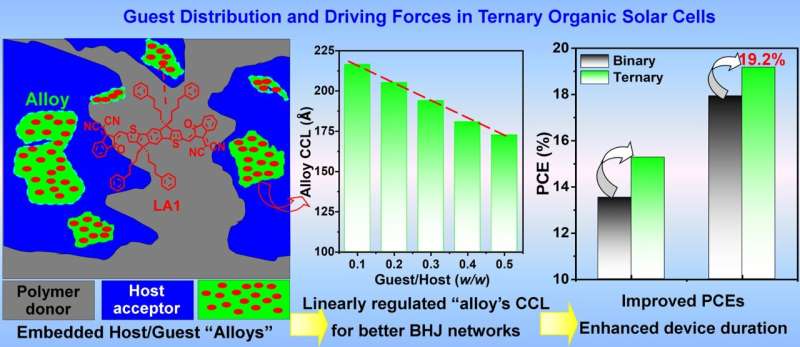This article has been reviewed according to Science X's editorial process and policies. Editors have highlighted the following attributes while ensuring the content's credibility:
fact-checked
peer-reviewed publication
trusted source
proofread
Flexible solar cell achieves major power conversion efficiency gains

Researchers from the Qingdao Institute of Bioenergy and Bioprocess Technology (QIBEBT) of the Chinese Academy of Sciences (CAS) have tweaked the material of ternary organic solar cells (TOSCs) and achieved efficiencies in reach of their conventional solar-cell cousins. The results were published in Advanced Materials on July 31.
Organic photovoltaic solar cells (OSCs) are a type of solar cell that use organic materials, typically composed of small molecules or polymers, to convert sunlight into electricity, distinct from traditional inorganic solar cells, which use crystalline silicon or other inorganic materials.
One of the key advantages of OSCs is their flexibility and light weight. They can be cheaply manufactured in flexible rolls rather than rigid panels—using solution-based processes, like inkjet printing—making them suitable for diverse applications such as sensors, portable chargers or wearable electronics. OSCs can also be designed to be semi-transparent or in various colors, allowing for aesthetic integrations into buildings, windows, or other structures.
However, OSCs have lower power conversion efficiencies (PCE) than inorganic solar cells. TOSCs have changed the situation to some extent. Unlike the traditional binary organic solar cells, which consist of a donor material and an acceptor material, TOSCs include an additional third component, often referred to as the "guest." This guest component is introduced to optimize various aspects of the solar cell's operation, from tweaking the cell's internal energy flows to improving how the cell converts light into power.
Of particular interest for PCE gains, the guest component can also broaden the spectrum of light that can be absorbed. By selecting a guest material that absorbs light in a range not covered by the donor or acceptor, the overall sunlight absorption of the cell can be increased. Meanwhile, the blend film morphology, where exciton dissociation, charge generation and transport proceed, can be well tuned.
Given the many different functions that the guest component can play, its specific location within the solar cell "sandwich" or matrix can radically alter performance. "Depending on its placement, the guest component can either transfer energy lightning-fast or help capture more sunlight," said Li Yonghai, co-author of the study.
There are three different location possibilities: embedded in the donor material, embedded in the acceptor material, or dispersed in some way between the interface of donor and acceptor, forming blended, alloy-like structures (aggregations). But until now, very little attention has been paid to playing around with guest component location.
In their study, the researchers used a guest component called LA1 (which differs from other guest component materials with respect to their crystallinity) in the TOSC. LA1 is a small molecule acceptor that the researchers modified with phenylalkyl side chains—a functional group (collections of atoms within molecules that have their own set of properties) that is commonly used in the design of organic materials for use in photovoltaic devices. The LA1 was modified with the phenylalkyl side chain to improve its crystallinity and alignment while maintains satisfactory compatibility, in turn enhancing its performance in the TOSC.
In addition, the researchers regulated the distribution of their guest component by playing around with various conditions that govern interaction with the host components, including host/guest compatibility, surface energy, crystalline kinetics, and intermolecular interactions. By doing so, they found alloy-like aggregations within most of the guest molecules, which also permeated and dispersed into the host molecules.
Impressively, the crystalline size of these embedded host/guest "alloys" can be easily fine-tuned for improved electric charge transport and suppressed charge recombination. As a result, the researchers were initially able to achieve PCE gains of over 15%, and then by combining their guest component with the Y6 family of acceptors as host component, they achieved still greater efficiency gains of over 19%.
The researchers feel they have achieved considerable experimental success, but the driving forces of these gains remains less well understood theoretically. Moving forward, the researchers hope to better clarify these underlying mechanisms.
More information: Xiaoning Wang et al, Embedded Host/Guest Alloy Aggregations Enable High‐Performance Ternary Organic Photovoltaics, Advanced Materials (2023). DOI: 10.1002/adma.202305652

















